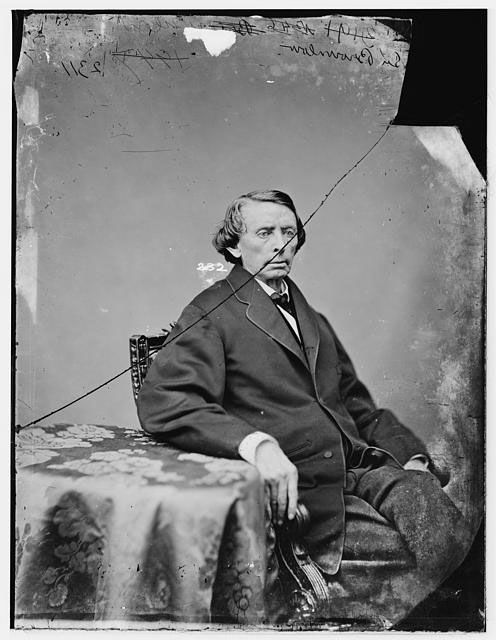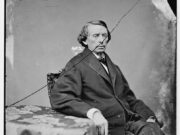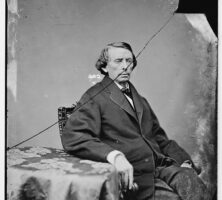Historians of the Civil War (1861-65) have only recently begun serious study of Unionists, an often overlooked group of white southerners who played a substantial part in sowing discontent and undermining the Confederate war effort. Unionists found themselves living in a new nation, the Confederacy, to which they chose not to give their allegiance. While their numbers in Georgia (or in any other southern state) are uncertain, much about Unionist presence and activity in the state has come to light in recent years.
One of the challenges for historians of wartime Unionism in the South lies in the secrecy surrounding Unionist identities and activities. Many were careful not to leave paper trails that could fall into the wrong hands and serve as evidence with which Confederate neighbors could indict them. Nevertheless, scholars have found a number of ways to reconstruct the labors of this shadowy, often underground, movement in Georgia, as well as the lives of the men and women involved in it.
Another problem lies in defining the term Unionist. Many southerners, simply apathetic about the war and the issues for which it was fought, sought to avoid any military involvement or dissented against the often intrusive Confederate policies toward civilians. But neither of these stances made one a true Unionist. Most scholars agree that sheer disaffection and neutrality toward the war are not characteristics of Unionism. Perhaps the best definition comes from William G. “Parson” Brownlow of East Tennessee, one of the most prominent southern Unionists, who cited three essential traits of a true Unionist: an “uncompromising devotion” to the Union; an “unmitigated hostility” to the Confederacy; and a willingness to risk life and property “in defense of the Glorious Stars and Stripes.”

Courtesy of Library of Congress, Prints and Photographs Division
Within Georgia, the Unionist experience offers stories as dramatic and varied as those in any other part of the Confederacy. From Atlanta to Savannah, from the northern mountains to the wiregrass and piney woods of south Georgia, these so-called enemies of the country survived, sometimes barely, as a small, secretive, and vulnerable minority in the midst of tremendous hostility, oppression, and danger.
Georgians in Blue
The geographical distribution of committed southern Unionists is revealed in part by who joined the Union army. In his book Lincoln’s Loyalists, historian Richard Current indicates that as many as 100,000 white Southerners became Union soldiers at some point over the course of the war, and that 70 percent of those came from Tennessee, Virginia, and West Virginia. Georgia supplied fewer Union troops than did any other Southern state except South Carolina. Approximately 400 Georgians enlisted in Union military units, compared with around 5,000 in North Carolina, more than 3,000 in Alabama, and a remarkable 42,000 in Tennessee.
Of the few Georgians who chose to join Union forces, most were from the mountains and had to cross state lines to enlist. As many as 270 Georgians enlisted in the First Alabama Cavalry, organized near Huntsville in mid-1862. Nearly half the Fifth Tennessee Mounted Infantry consisted of exiled Georgia Unionists. In November 1864 eight men from Fannin, Towns, and Union counties, all poor farmers who had deserted the Confederate army, were on their way to join the Fifth Tennessee in Cleveland, Tennessee, when they encountered John P. Gatewood’s notorious Confederate guerrilla force near the state line. In what came to be known as the Madden Branch Massacre, Gatewood’s men captured six of the eight, lined them up, and gunned them down at close range.
The First Georgia State Troops Volunteers, organized in the spring of 1864 during Union general William T. Sherman’s Atlanta campaign, was the only official Union force established within the state. Its approximately 200 enlistees were motivated as much by the defense of their homes against Confederate raids into the mountains as by any loyalty to the Union. Given this priority, many of its troops chose to flee back home rather than stay put and hold Dalton when it came under Confederate attack in October 1864. The First Georgia’s commander, Union general James Steedman, called the battalion “utterly worthless” and ensured that it was disbanded a month later.
Home Front Activity
Although few Georgians ever wore Union uniforms during the war, significant numbers of Unionist civilians, either on their own or in small, often secret communities, made concerted efforts on behalf of the Union and against the Confederacy over the course of the war. Much of that activity was concentrated in north Georgia, where the relative lack of slavery or a slave-based economy, along with the region’s social and commercial isolation, gave many mountain residents little reason to support the Southern cause. Such sentiments were never universal, and the divisions among Georgia’s highland residents often led to violent and vicious guerrilla warfare, as exemplified by the Madden Branch Massacre.
Given that highland Unionists often enjoyed a critical mass not apparent in other parts of the state, they formed small independent and irregular bands that waged localized campaigns to defend their families and property from Confederate forces, which were often guerrilla bands themselves. As tensions escalated in the war’s latter half, many of these same “Tory” bands, made up of true Unionists as well as deserters and other dissenters, resorted to more aggressive actions, including brutal vendettas against Confederate neighbors, home guard units, or conscription officials.
Pockets of Unionists, often working even further underground than the rural highlanders, appeared in Georgia cities as well. Researchers have gathered information (much of it anecdotal) about these urban Unionists from their journals and diaries, several of which have been discovered in recent years. An anonymous document, long known as “Miss Abby’s Diary,” proved to be a major source of information on a small, but fully engaged, Unionist community in Atlanta. Historian Thomas G. Dyer decoded the diary and discovered that its author, Vermont native Cyrena Stone, had moved to Fayetteville, Georgia, with her husband in 1850 and then to Atlanta around 1853. When the war broke out, they found themselves, along with other so-called secret Yankees, faced with constant surveillance, social ostracism, and persecution from local law enforcement.
This group of no more than 100 families found various means not only to survive but also to subvert Confederate war efforts. They helped Union prisoners of war and wounded soldiers brought into the city for either incarceration or treatment, and provided information to Union forces as they approached Atlanta. Once Sherman’s troops occupied the city, its Unionist residents were allowed to remain for several weeks after the rest of the populace was forced to evacuate. The Unionists eventually left the city as well, and many returned to the North.
Other accounts by Unionist women suggest that they lived in isolated situations, lacking even the small network of fellow loyalists found in Atlanta. Dix and Louisa Fletcher, also New England transplants, operated a hotel on the square in Marietta. In her journal, Louisa Fletcher recounts considerable harassment by local residents suspicious of the couple’s loyalties, and ostracism that continued well after the war’s end. The war even alienated the Fletchers from their adult daughters, who cast their lot with the Southern cause. Nellie Kinzie Gordon, a native of Chicago, Illinois, felt even more isolated as the wife of prominent Savannahian William Washington Gordon II. (She was also the mother of Girl Scouts founder Juliette Gordon Low). Living with her in-laws in Savannah, and under constant scrutiny by local residents, she was far more guarded, and even ambivalent, in her professions of Union loyalty. Her situation was further complicated by the fact that her uncle, Union general David Hunter, had enraged Savannah residents by capturing and occupying nearby Fort Pulaski.
These stories, and others like them, suggest that the experiences of Georgia Unionists varied greatly. The degree of activity, sentiment, and commitment to the Union cause was often dictated by setting and circumstance, and no two of these cases are alike in terms of what factors drove loyalty to the Union. This loyalty was expressed in myriad ways, ranging from the passive aiding and abetting of Union prisoners or hospital patients, to the aggressive joining of Union ranks. Much depended on where one happened to be and what opportunities presented themselves.





